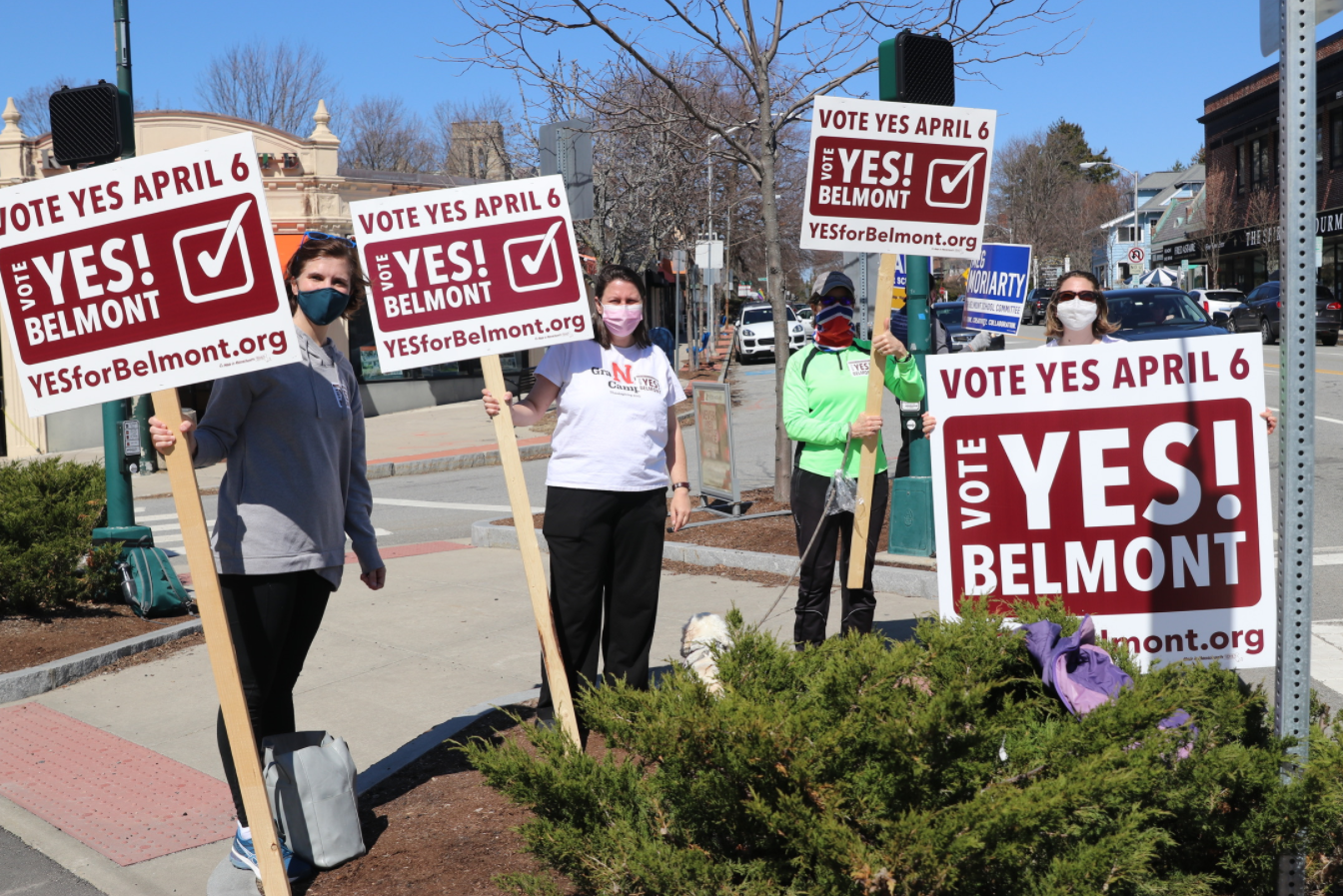Photo: Campaigners for the Yes for Belmont ballot question
The Belmontonian is providing candidates/campaigners of ballot questions in contested races the opportunity to make a request for votes in the final week of the election race.
Vote Yes on April 6. It’s up to us to support the future of Belmont.
For many of us in Belmont, the start of spring this month has come with a renewed sense of hope and optimism, as residents get vaccinated and schools begin to re-open more fully.
While there is good reason for all Belmontonians to feel hopeful about the future, we still have a lot of work ahead to heal our community, help Belmont bounce back from a tough year, and make sure Belmont is a place where all residents feel welcome and supported.
On top of all this, our town is facing a looming fiscal crisis. Despite every effort to cut spending and increase revenue since 2015, what it costs to provide the basic minimum level of services continues to rise faster than our revenue. Even after assuming we spend down our cash reserves in a fiscally responsible way over three years, Belmont is still facing a $20 million deficit over the next three years.
We have a plan to address this looming crisis: Passing the override by voting Yes on April 6.
Supporting the override means we can address our structural deficit in a fiscally responsible way. It means we can preserve what we love about Belmont from our library programs to our parks and playgrounds. It means our students can return to school with the support they need and we can reduce Belmont’s notoriously large class sizes, which ballooned when more than 900 students enrolled in Belmont’s schools in the past 13 years.
Moreover, there is a cost to doing nothing. After the failed override of 2010, our roads and sidewalks fell apart and our high school students had classes replaced with “free periods.” If we don’t pass this override, we will face similar cuts beginning this summer; $3.45 million will be cut from our school and town budgets after depleting our cash reserves. That means a net loss of 21 school positions next year, erasing all the progress we’ve made since 2015 in reducing class sizes. It means reducing the budget for athletics, music, theater and the arts by 40 percent. These cuts and more will prolong the impact of the pandemic on our students, just when we’re all looking for a fresh start.
It also means cuts to the town services we all rely on every day. Our library will need to reduce hours, cut programs, and will be barely above the budget threshold it must meet to stay in the Minuteman Library Network. Our Department of Public Works will continue to plow the same number of streets, but with fewer resources, meaning delays for residents. Such cuts would be penny wise and pound foolish if they force our emergency response teams to rely on overtime rather than routine staffing to meet public safety needs. The cuts to our town services will impact the quality of life in Belmont for all of us.
Our structural deficit won’t be solved by one-time federal funds. The federal aid, while good for Belmont, is either restricted or is needed to pay for COVID expenses next year that were not included in the budget. Current estimates are that only $700,000 to $1.1 million of the federal aid could be used to cover our general operating expenses. That’s not nearly enough to address our $5.7 million deficit next year, let alone the $20 million gap over the next three years.
And if we delay, our deficit will only continue to grow. A bigger deficit means we will need a bigger override in the future to keep the same services intact. It is more expensive to taxpayers if we wait.
As we try to turn the page on a uniquely tough year, let’s join together as a community and take the steps needed to ensure our town can bounce back and face the challenges ahead of us on solid financial ground. Passing the override ensures we can preserve our town services, support our students and put Belmont on a fiscally responsible path for the future. It’s up to us to support the future of Belmont. It’s up to us to Vote Yes on April 6.








I notice “Yes on 1” yard signs mostly in front of the homes of the visibly more affluent, whereas “No on 1” signs seem largely to be posted by Belmont’s working class. This may be an overgeneralization, but to the extent that support appears at all to be breaking across class lines, this cannot be ignored. I see that the tax increase will be graduated according to assessed property value, but this doesn’t account for the possibility that some people’s property values have gone up while their incomes have gone down. I get the impression that the “Yes on 1” crowd is paying too little attention to this problem, perhaps even dismissing it, which may reflect, in part, some amount of class privilege. How can these vital funds be collected in a way that is fairer than this current plan?